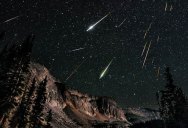Picture of the Day: The Perseids Meteor Shower
THE PERSEIDS METEOR SHOWER
In this stunning capture we see the Perseids meteor shower as observed from the Snowy Range in Wyoming. The photograph was taken the night of August 11th by professional photographer David Kingham.
Kingham explains:
“I went out to Snowy Range in Wyoming in search of dark skies for the Perseid meteor shower. I wanted something special for the foreground and I knew the Snowies faced in the perfect direction to get this shot. I started shooting at 10pm and didn’t stop until 5 am, I had to change my battery every 2 hours which made for a long night. The moon rose around 1am to light up the mountain range.
This is a composite of 23 images, 22 for the meteors/stars and 1 taken at sunrise for the foreground which was lightly blended in. I also corrected the orientation of the meteors to account for the rotation of the earth (this took forever!)” – Source:Flickr
The Perseids are a prolific meteor shower associated with the comet Swift-Tuttle. The Perseids are so-called because the point from which they appear to come, called the radiant, lies in the constellation Perseus.
The stream of debris is called the Perseid cloud and stretches along the orbit of the comet Swift-Tuttle. The cloud consists of particles ejected by the comet as it travels on its 130-year orbit. Most of the dust in the cloud today is around a thousand years old. However, there is also a relatively young filament of dust in the stream that was pulled off the comet in 1862.
The Perseid meteor shower has been observed for about 2000 years, with the earliest information on this meteor shower coming from the Far East. The shower is visible from mid-July each year, with the peak in activity being between August 9 and 14, depending on the particular location of the stream.
During the peak, the rate of meteors reaches 60 or more per hour. They can be seen all across the sky, but because of the path of Swift-Tuttle’s orbit, Perseids are primarily visible in the northern hemisphere. [Source: Wikipedia]





